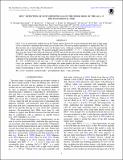Files in this item
HCO+ detection of dust-depleted gas in the inner hole of the LkCa 15 pre-transitional disk
Item metadata
| dc.contributor.author | Drabek-Maunder, E. | |
| dc.contributor.author | Mohanty, S. | |
| dc.contributor.author | Greaves, J. | |
| dc.contributor.author | Kamp, I. | |
| dc.contributor.author | Meijerink, R. | |
| dc.contributor.author | Spaans, M. | |
| dc.contributor.author | Thi, W. F. | |
| dc.contributor.author | Woitke, P. | |
| dc.date.accessioned | 2017-01-16T10:30:16Z | |
| dc.date.available | 2017-01-16T10:30:16Z | |
| dc.date.issued | 2016-12-20 | |
| dc.identifier | 248897304 | |
| dc.identifier | 39747589-b0b2-4e64-8e56-b93164590b8a | |
| dc.identifier | 85007610579 | |
| dc.identifier | 000391169600135 | |
| dc.identifier.citation | Drabek-Maunder , E , Mohanty , S , Greaves , J , Kamp , I , Meijerink , R , Spaans , M , Thi , W F & Woitke , P 2016 , ' HCO + detection of dust-depleted gas in the inner hole of the LkCa 15 pre-transitional disk ' , Astrophysical Journal , vol. 833 , no. 2 , 260 . https://doi.org/10.3847/1538-4357/833/2/260 | en |
| dc.identifier.issn | 0004-637X | |
| dc.identifier.uri | https://hdl.handle.net/10023/10108 | |
| dc.description.abstract | LkCa 15 is an extensively studied star in the Taurus region, known for its pre-transitional disk with a large inner cavity in the dust continuum and normal gas accretion rate. The most popular hypothesis to explain the LkCa 15 data invokes one or more planets to carve out the inner cavity, while gas continues to flow across the gap from the outer disk onto the central star. We present spatially unresolved HCO+ J = 4 → 3 observations of the LkCa 15 disk from the James Clerk Maxwell telescope (JCMT) and model the data with the ProDiMo code. We find that: (1) HCO+ line-wings are clearly detected, certifying the presence of gas in the cavity within ≲50 au of the star. (2) Reproducing the observed line-wing flux requires both a significant suppression of cavity dust (by a factor ≥ 104 compared to the interstellar medium (ISM)) and a substantial increase in the gas scale-height within the cavity (H0/R0 ∼ 0.6). An ISM dust-to-gas ratio (d:g = 10-2) yields too little line-wing flux, regardless of the scale-height or cavity gas geometry, while a smaller scale-height also under-predicts the flux even with a reduced d:g. (3) The cavity gas mass is consistent with the surface density profile of the outer disk extended inwards to the sublimation radius (corresponding to mass Md ∼ 0.03 M⊙), and masses lower by a factor ≥10 appear to be ruled out. | |
| dc.format.extent | 19 | |
| dc.format.extent | 3428247 | |
| dc.language.iso | eng | |
| dc.relation.ispartof | Astrophysical Journal | en |
| dc.subject | Accretion, accretion disks | en |
| dc.subject | Protoplanetary disks | en |
| dc.subject | Stars: protostars | en |
| dc.subject | QB Astronomy | en |
| dc.subject | QC Physics | en |
| dc.subject | Astronomy and Astrophysics | en |
| dc.subject | Space and Planetary Science | en |
| dc.subject | NDAS | en |
| dc.subject.lcc | QB | en |
| dc.subject.lcc | QC | en |
| dc.title | HCO+ detection of dust-depleted gas in the inner hole of the LkCa 15 pre-transitional disk | en |
| dc.type | Journal article | en |
| dc.contributor.institution | University of St Andrews. School of Physics and Astronomy | en |
| dc.contributor.institution | University of St Andrews. St Andrews Centre for Exoplanet Science | en |
| dc.identifier.doi | 10.3847/1538-4357/833/2/260 | |
| dc.description.status | Peer reviewed | en |
| dc.identifier.url | https://arxiv.org/abs/1609.05894 | en |
This item appears in the following Collection(s)
Items in the St Andrews Research Repository are protected by copyright, with all rights reserved, unless otherwise indicated.

